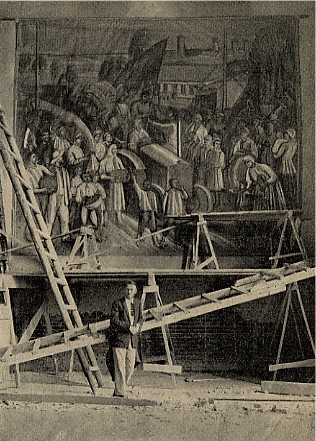Fresco painting
Fresco painting. A method of painting on freshly plastered walls with powdered pigments that are resistant to the erosive action of lime. Before the colors are applied to the wet plaster the main lines of the composition are usually traced on the preceding coat. The painting is very durable and is applied to both interior and exterior walls.
The origins of fresco painting in Ukraine can be traced back to the 4th century BC. Frescoes adorned the homes, public buildings, and tombs of the Greek colonists (see Ancient states on the northern Black Sea coast; fresco in Chersonese Taurica) and Scythians on the coast of the Black Sea. The most interesting ancient frescoes from the 1st century BC were discovered during excavations of burial sites in Kerch in the tomb of Demeter (depiction of Hades kidnapping Demeter's daughter, Persephone; head of Demeter). A fresco on a stone sarcophagus depicting a painter's studio (now preserved at the Hermitage Museum in Saint Petersburg) dates back to the same period.
In the Kyivan Rus’ the fresco was the principal method of decorating church interiors. Mosaics adorned churches only in the 11th and 12th centuries and were limited to the central part, while frescoes covered all the side apses, vaults, columns and walls of the side naves, and sometimes even the arch supports, galleries, niches, and external portals. In Byzantium, mosaics were never mixed with frescoes in the same building; this is a unique practice of Ukrainian church art. Harmony between mosaic and fresco was achieved by using the same dominant colors. The most famous examples of this decorative system are Saint Sophia Cathedral (1037) (see photo) and the Cathedral of Saint Michael's Golden-Domed Monastery (mid-12th century, destroyed by the Soviets in 1936, then rebuilt in independent Ukraine in the late 1990s) in Kyiv. A different Kyiv school of fresco painting was represented by the painters who decorated the Dormition Cathedral of the Kyivan Cave Monastery (11th century, destroyed by the Soviets in 1941; rebuilt in the late 1990s).
The frescoes of Saint Sophia Cathedral are painted on a two-layer plaster base 1.5–2 cm thick and strengthened with chopped straw. The cool blue, white, purple, and green colors predominate in both the frescoes and mosaics, creating a reverential mood. In the main apse, near the mosaic of The Mother of God (Orante), frescoes depict various scenes from the life of the Mother of God and her parents (eg. Annunciation); the main events in the life of Christ appear in the central nave (eg., The Descent into Hell). Another series of frescoes, dealing with the Christological cycle, adorns the second level. Of particular interest are the secular frescoes: episodes from court life, hippodrome events, hunting scenes, musicians, acrobats, and minstrels (skomorokhy) are depicted in the two towers; there are figural portraits of Prince Yaroslav the Wise and his children in the main nave (see fresco of Prince Yaroslav's Family). The prevalent ornament (see Saint Sophia Cathedral fresco ornament), consisting of braided coils of straw worked into a geometric pattern, reappears in other Kyiv, Chernihiv, and Novgorod frescoes of the 11th–12th century. The surviving frescoes of the Cathedral of Saint Michael's Golden-Domed Monastery (such as the Annunciation) suggest that the interior was decorated with brighter colors and that the characters were portrayed according to different artistic conventions than in the Saint Sophia Cathedral; for example, the apostles in the mosaic of the sanctuary lack aureolas. The apostles of the 11th–12th century found in frescoes of Saint Michael's Church (aka Yurii's Temple) in Oster near Pereiaslav are similarly portrayed, but in a warmer color scheme dominated by red and ocher. The appearance of local features in character depiction, however, relates these figures more closely to those found in the frescoes of Saint Nicholas's Rotunda Chapel in Horiany in Transcarpathia. Fragments of frescoes from the following Chernihiv cathedrals have also been preserved: the Cathedral of the Transfiguration (early 11th-century depiction of Saint Teklia), the Saints Borys and Hlib Cathedral, the Dormition Cathedral of Yeletskyi Dormition Monastery (Monastery Orante fresco.jpg">Orante, etc), the Church of Good Friday. Traces of frescoes were found in Pereiaslav during the excavations of Saint Michael's Cathedral (built 1089), in the Church of the Savior in Posada, and in other churches.
After the middle of the 12th century frescoes almost completely replaced mosaics in the decoration of church interiors. The most complete set of frescoes from this period has been preserved in the church of Saint Cyril's Monastery in Kyiv and in the Transfiguration Church in Berestove in which a 12th-century fresco ‘Miraculous Fishing’ was uncovered in the 1970s. The influence of Balkan art is evident. Frescoes depicting the sacraments of the Eucharist and the holy orders are found under the traditional Orante in the altar apse and, as in Bulgaria, are imitations of hanging icons. On the walls and vault of the narthex appear the first paintings of the Last Judgment and scenes of the Apocalypse known in Ukraine. In contrast to the idealized figures of Saint Sophia Cathedral's frescoes, the figures of Saint Cyril's Monastery display features of the local population. The colors are bright and warm, dominated by ocher and red (eg., Presentation at the Temple). The vaults and walls are covered with numerous scenes representing a new type of decorative art, which was characteristic of the 12th-century Kyiv school of church painting.
It is evident from numerous monuments that in this period the Chernihiv principality, Pereiaslav principality, Halych principality, and Volhynian principality (see Principality of Galicia-Volhynia) already had their own schools of church painting. Preserved fragments of frescoes from the 14th century demonstrate that the same techniques used in the Kyiv school were used here. Among the better preserved are the 14th–15th century frescoes in Polish churches of the Sandomierz, Sieradz, and Cracow regions executed by Ukrainian masters, probably from Galicia and Volhynia; the frescoes of the Holy Trinity Chapel in Lublin done in 1418 by a group of nine or ten painters under the direction of Master Andrii; the frescoes of Sandomierz Cathedral done in the 1430s; the paintings of Wiślica Collegiate Cathedral from the 14th century (by master Hail); and the paintings in the Holy Cross Chapel of the Wawel Cathedral in Cracow (1470). In all these churches the frescoes, which are based on Byzantine tradition, are skillfully integrated with the Gothic architecture of the interior. More dramatic and dynamic than their Byzantine models, they often depart from conventional scenes. Western European influences are evident in the iconography. The lively colors of the frescoes are complemented by the floral-geometric ornamentation. The synthesis of traditional Ukrainian painting with the Gothic style is particularly successful in the Chapel of the Holy Cross in Wawel.
Among the monuments of the 15th century are the partly preserved frescoes of the church of Lavriv Saint Onuphrius's Monastery, in which the Mother of God is the central figure and is depicted in various ways, particularly as the protectress modelled on the Western European Madonna. These highly ornamented paintings are stylistically similar to the frescoes in Wiślica and Sandomierz, and to those of the Dormition Church in the village of Luzhany in Bukovyna.
The development of fresco painting was halted by the spread of wooden churches and the use of simpler painting techniques in decorating secular buildings. Attempts to revive the art came only in the early 20th century, when the fresco technique was studied by such artists as Tymofii Boichuk, Kyrylo Hvozdyk, A. Ivanova, Oleksander Myzin, Oksana Pavlenko, Ivan Padalka, Vasyl Sedliar, Mykola Rokytsky, and Manuil Shekhtman in the studio of Mykhailo Boichuk at the Kyiv State Art Institute. These painters took part in composing many frescoes in Kyiv, which depict the daily life of the workers and resemble the folk paintings and icons of the 17th–18th century; a series of frescoes at the Peasant Sanatorium in Odesa (1928), which depict the work of the peasants; the frescoes at Mezhyhiria tekhnikum (Sedliar and Pavlenko); and the frescoes in the Children's Village in Kyiv (1924, Dmitrii Shavykin and I. Zhdanko). Many tempera and fresco paintings (secco) in 1929–32 were done on dry plaster by artists from Odesa or the Odesa region: the murals of the Press Building (1929–30, by Mykola Pavliuk, H. Dovzhenko, Yo. Hurvych, I. Pasternak, and Ya. Tymofeev), the GPU Club (1930–1, by P. Parkhet, I. Pasternak. Yo. Hurvych, and Ya. Tymofeev), and the Eastern Chamber of Commerce (1927, by H. Komar and H. Dovzhenko). The influence of Mykhailo Boichuk's school on these artists is evident. Under the direction of Lev Kramarenko, I. Zhdanko and Yurii Sadylenko decorated the walls of the conference hall in the building of the All-Ukrainian Academy of Sciences with frescoes in 1930. Boichuk's last frescoes, on which he collaborated with Sedliar and Padalka, were painted in the Kharkiv Chervonozavodskyi Ukrainian Drama Theater in 1933–5. All three artists were charged with formalism and perished in exile. Most of their works were destroyed. Henceforth fresco painting declined in Ukraine.
BIBLIOGRAPHY
Lobanovs’kyi, B. Mozaïka i freska (Kyiv 1966)
Mamolat, Ie. ’Monumental’nyi zhyvopys,’ in Istoriia ukraïns’koho mystetstva v shesty tomakh, 1 (Kyiv 1966)
Lohvyn, H. ’Monumental’nyi zhyvopys XIV–pershoi polovyny XVII stolittia,’ in Istoriia ukraïns’koho mystetstva v shesty tomakh, 2 (Kyiv 1967)
Vrona, I; Lobanovs’kyi, B. ’Monumental’nyi zhyvopys,’ in Istoriia ukraïns’koho mystetstva v shesty tomakh, 5 (Kyiv 1967)
Bielichko, Iu. ‘Monumental’nyi zhyvopys,’ in Istoriia ukraïns’koho mystetstva v shesty tomakh, 6 (Kyiv 1968)
Logvin, G. Kiev's Hagia Sophia (Kyiv 1971)
Sviatoslav Hordynsky
[This article originally appeared in the Encyclopedia of Ukraine, vol. 1 (1984).]

.jpg)
.jpg)
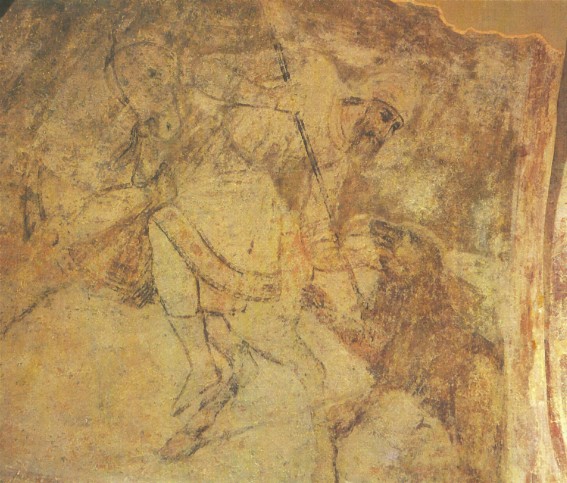
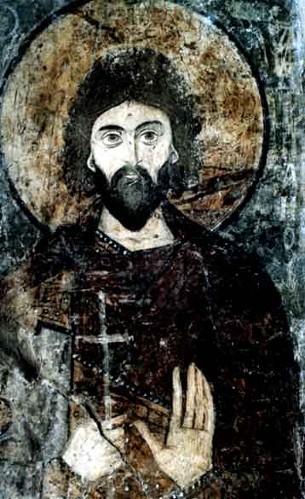
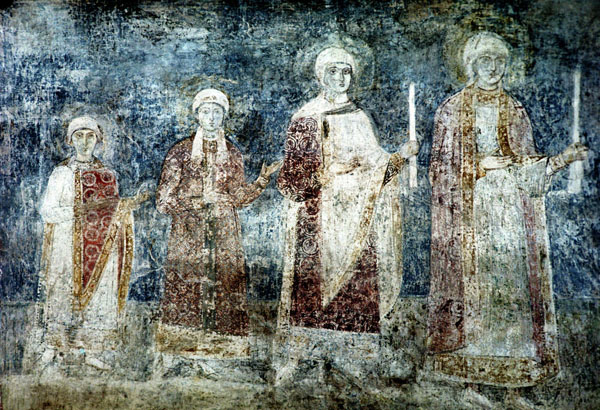
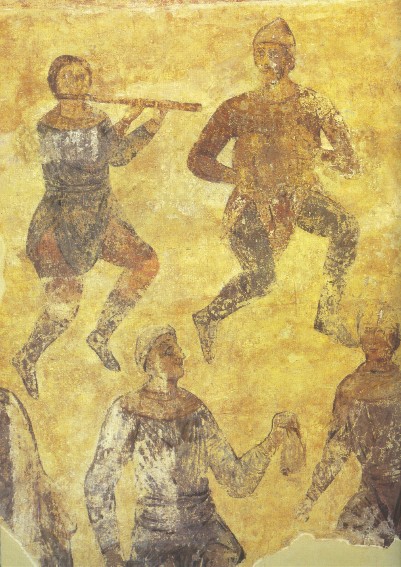
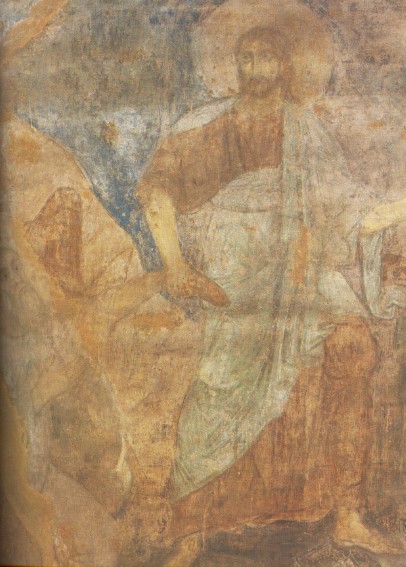
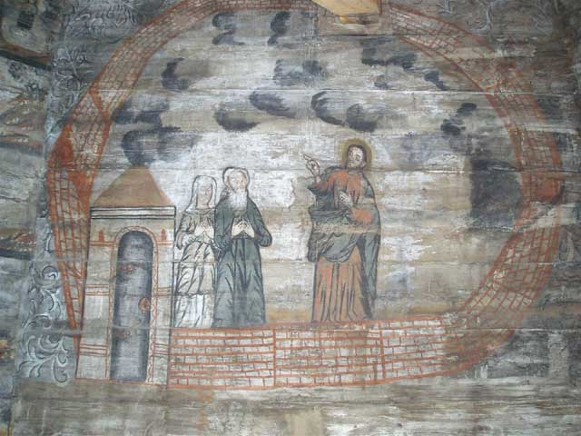
.jpg)
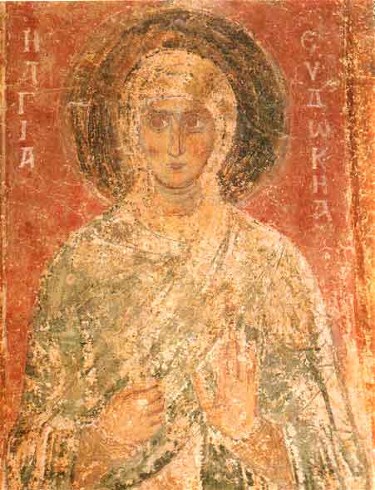
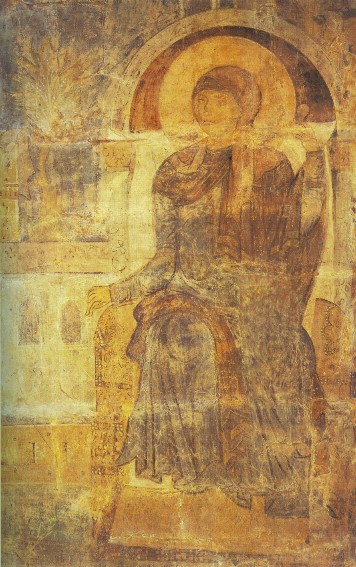
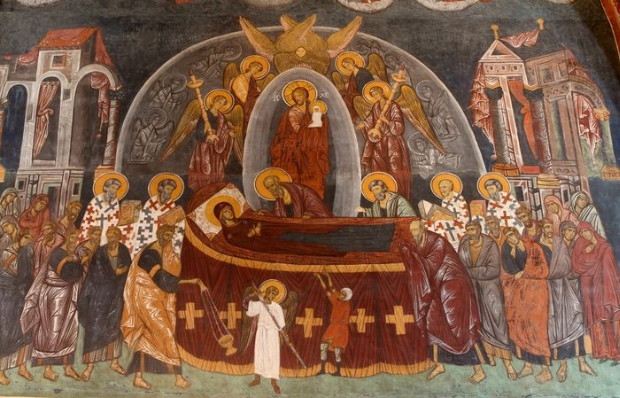
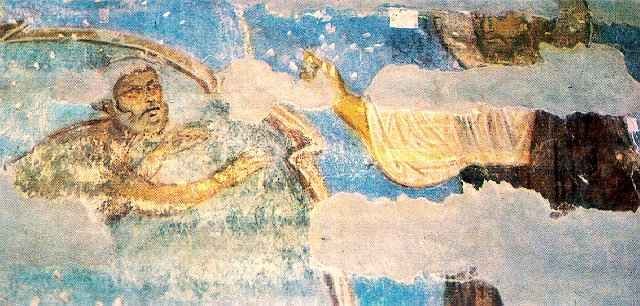
.jpg)
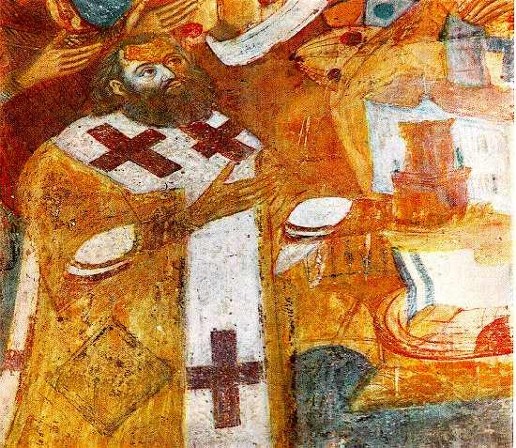
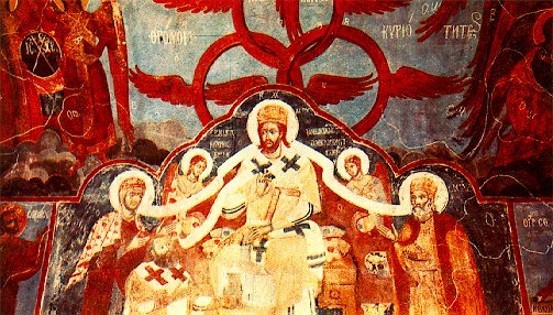
.jpg)
.jpg)
%20(1730-40).jpg)
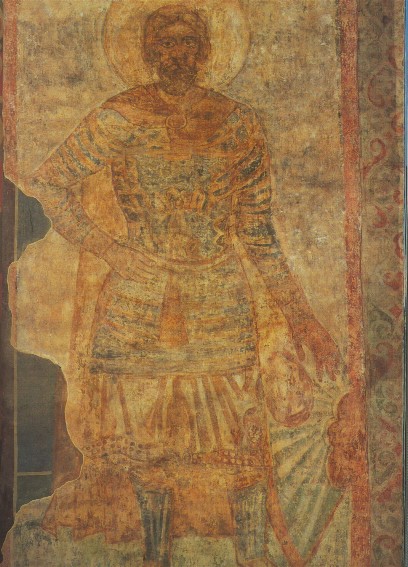
.jpg)
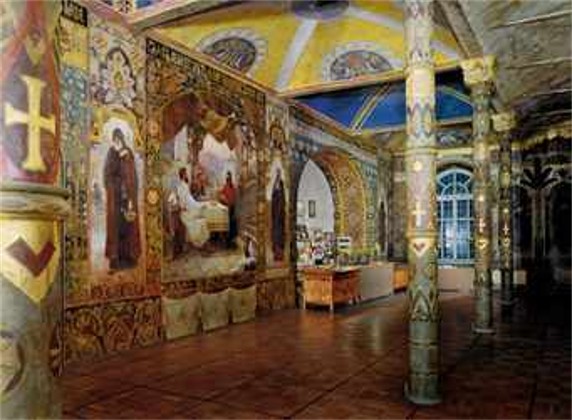
.jpg)
%20(1730-40).jpg)
